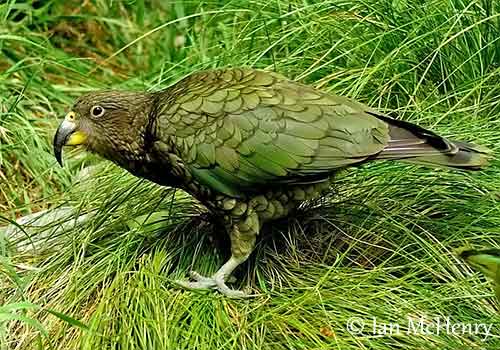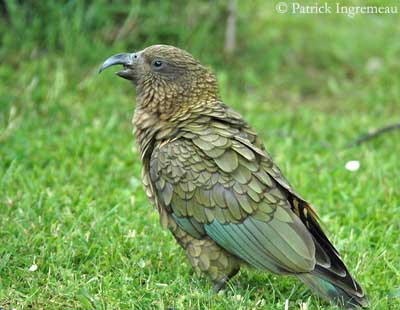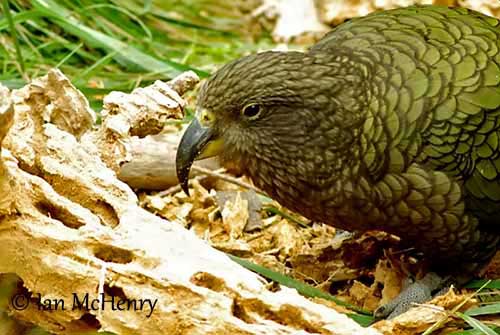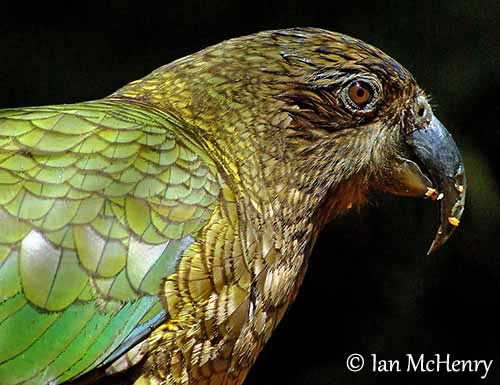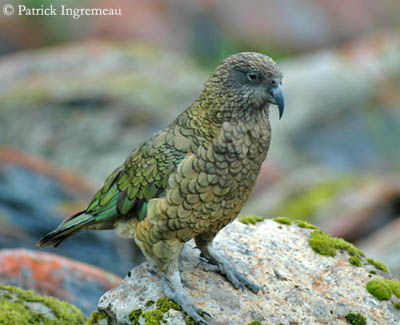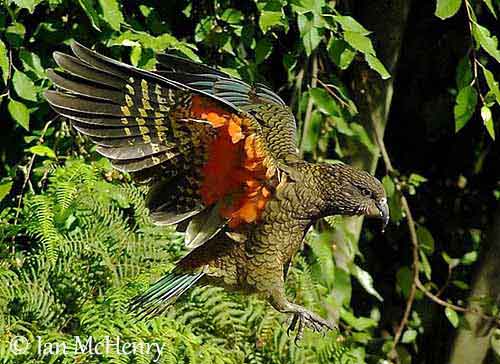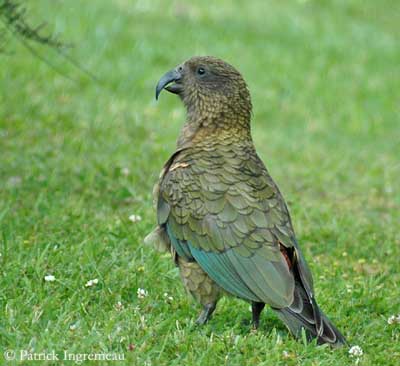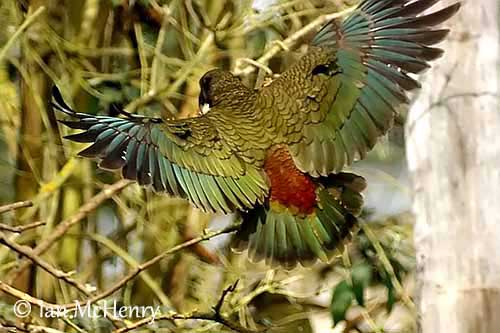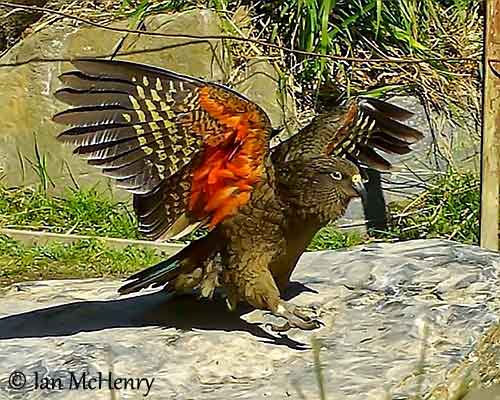
Kea
Nestor notabilis
Psittaciforme Order - Strigopidae Family
BIOMETRICS:
Length: 46-50 cm; Weight: M: 920g – F: 800g
LONGEVITY : 14 years
DESCRIPTION:
The Kea is an alpine parrot, endemic to New Zealand where it is named “the clown of New Zealand’s Southern Alps”.
The adult has bronze-green upperparts. Lower back is dull red, extending to uppertail coverts. Feathers are edged with black, giving plumage a scaly appearance.
The underparts are brownish olive-green. Underwing coverts are orange-red, with yellow and black barring, extending to the flight feathers undersides. Outer webs of primaries are blue. Undertail feathers are dull yellow.
The head is bronze-green. the bill is blackish with long, decurved, deeply hooked upper mandible. The eyes are dark brown, with fine yellow eye-ring. Legs and feet are bluish-grey.
The female is similar in plumage, but she has shorter bill, with less curved culmen, and is smaller than male.
The juvenile has yellowish crown, cere and lower base of the bill.
VOICE: SOUNDS BY XENO-CANTO
Kea’s name is coming from its call, resounding through peak’s mist. Its call is a shrill, echoing “Keee-aa”, uttered while it is soaring high. On the ground, the Kea utters soft murmurings and whistles.
HABITAT:
The Kea lives in high-country forests, steep wooded valleys, steep mountains, and forests at the edges of sub-alpine scrublands, at 600 to 2,000 metres of elevation. It may occasionally descend to lower valleys.
In summer, the Kea lives in high elevation scrub and alpine tundra. In autumn, it moves to higher areas for eating berries. In winter, it moves below the timberline.
RANGE:
The Kea is found in the mountains of South Island in New Zealand.
BEHAVIOUR:
The Kea feeds on seeds, foliage, insects and nectar, as other parrots. But its sharp, hooked bill allows it to dig out roots and grubs. It also uses the upper part of its bill for tearing up carcasses, or when it attacks sickly sheep. They forage in the morning and evening, roosting during the afternoon on tree branches, as at night.
The Kea has also a murderous behaviour, attacking the Shearwater nest-holes. It stalks the place, listening with head cocked. Under the ground, the Shearwater chicks may occasionally call, and the Kea reacts very quickly, starting to dig. It uses its bill as a mattock and tears away the earth to reach the entrance and inside. At this moment, it uses its bill as a hook, and rips the chicks to pieces.
REPRODUCTION:
The copulation is often initiated by the female. She approaches the male and adopts a posture of submission, or solicits preening, or invites it to play. Before mounting the female, the male feeds her with regurgitated food.
The Keas can breed at any time of the year, except in late autumn. the usual period lasts from July to January.
The Keas nest in burrows under logs, rocks and tree roots, but also in cavities among boulders, and sometimes, they may build a nest over several years. They add plant material such as sticks, grasses, moss and lichens.
The female lays 2 to 4 eggs. The incubation lasts about 3 to 4 weeks, by female. She is fed by male, and rarely leaves the nest.
The altricial chicks are fed by female, but the food is brought at nest by the male. When the chicks reach one month, the male feeds them too, and during about 6 weeks.
The young fledge between 9 and 13 weeks of age, and they are still fed by the male alone.
Then, the juveniles disperse from the nest-site, and travel in flocks, until they reach their sexual maturity, at 3 years for females, and 4 to 5 years for males.
Fr: Nestor kéa
All : Kea
Esp : Kea
Ital : Kea
Nd : Kea
Russe : Кеа
Sd : Кеа
Photographers:
Ian McHenry
My New Zealand Birds
Patrick Ingremeau
TAMANDUA
Text by Nicole Bouglouan
Sources:
HANDBOOK OF THE BIRDS OF THE WORLD vol 4 by Josep del Hoyo-Andrew Elliott-Jordi Sargatal - Lynx Edicions - ISBN: 8487334229
L’ENCYCLOPEDIE MONDIALE DES OISEAUX - Dr Christopher M. Perrins - BORDAS - ISBN: 2040185607
KNOW YOUR NEW ZEALAND BIRDS by Lynnette Moon - New Holland Publishers – ISBN: 1869660897
PARROTS OF THE WORLD – An Identification Guide – by Joseph M. Forshaw – Princeton University Press – ISBN 0691092516
BirdLife International (BirdLife International)
Wikipedia (Wikipedia, The Free Encyclopedia)
New Zealand birds and birding (Narena Olliver)
Te Ara – The Encyclopedia of New Zealand
New Zealand bird status between 2008 and 2012
This behaviour and its habits to attack sheep had made the bird so unloved, and very numerous Keas were persecuted over the last 130 years.
The Kea is able to adapt, and may learn or create solutions in order to survive. They can explore and manipulate items in their habitat and destroy accessories of cars and others. This behaviour of destructiveness and curiosity is considered as aspects of play by scientists. It is often seen playing with twigs or stones, singly or in groups.
The Keas chase predators and intruders in groups, chasing them away if one bird of the group is threatened.
FLIGHT:
The Kea has strong flight. It soars high in the sky, into mountain mists, and seems to play on air currents.

